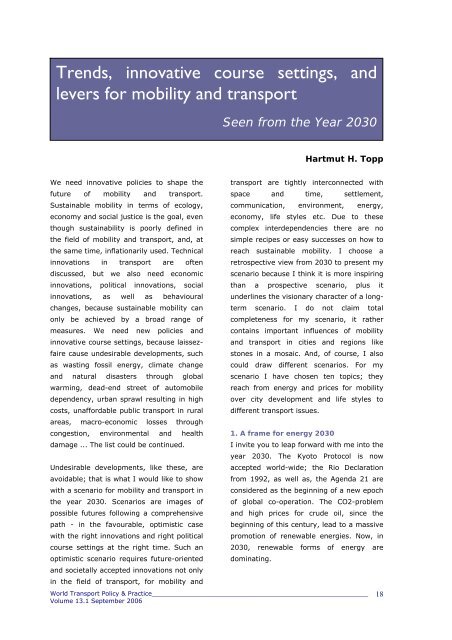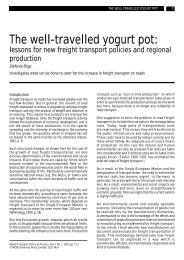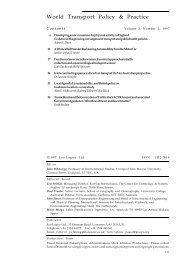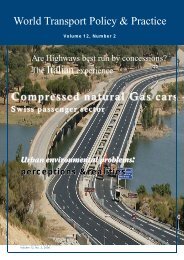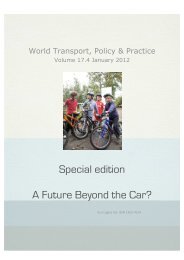Effects of pedestrianisation on the commercial and ... - Eco-Logica
Effects of pedestrianisation on the commercial and ... - Eco-Logica
Effects of pedestrianisation on the commercial and ... - Eco-Logica
Create successful ePaper yourself
Turn your PDF publications into a flip-book with our unique Google optimized e-Paper software.
Trends, innovative course settings, <strong>and</strong><br />
levers for mobility <strong>and</strong> transport<br />
We need innovative policies to shape <strong>the</strong><br />
future <str<strong>on</strong>g>of</str<strong>on</strong>g> mobility <strong>and</strong> transport.<br />
Sustainable mobility in terms <str<strong>on</strong>g>of</str<strong>on</strong>g> ecology,<br />
ec<strong>on</strong>omy <strong>and</strong> social justice is <strong>the</strong> goal, even<br />
though sustainability is poorly defined in<br />
<strong>the</strong> field <str<strong>on</strong>g>of</str<strong>on</strong>g> mobility <strong>and</strong> transport, <strong>and</strong>, at<br />
<strong>the</strong> same time, inflati<strong>on</strong>arily used. Technical<br />
innovati<strong>on</strong>s in transport are <str<strong>on</strong>g>of</str<strong>on</strong>g>ten<br />
discussed, but we also need ec<strong>on</strong>omic<br />
innovati<strong>on</strong>s, political innovati<strong>on</strong>s, social<br />
innovati<strong>on</strong>s, as well as behavioural<br />
changes, because sustainable mobility can<br />
<strong>on</strong>ly be achieved by a broad range <str<strong>on</strong>g>of</str<strong>on</strong>g><br />
measures. We need new policies <strong>and</strong><br />
innovative course settings, because laissezfaire<br />
cause undesirable developments, such<br />
as wasting fossil energy, climate change<br />
<strong>and</strong> natural disasters through global<br />
warming, dead-end street <str<strong>on</strong>g>of</str<strong>on</strong>g> automobile<br />
dependency, urban sprawl resulting in high<br />
costs, unaffordable public transport in rural<br />
areas, macro-ec<strong>on</strong>omic losses through<br />
c<strong>on</strong>gesti<strong>on</strong>, envir<strong>on</strong>mental <strong>and</strong> health<br />
damage ... The list could be c<strong>on</strong>tinued.<br />
Undesirable developments, like <strong>the</strong>se, are<br />
avoidable; that is what I would like to show<br />
with a scenario for mobility <strong>and</strong> transport in<br />
<strong>the</strong> year 2030. Scenarios are images <str<strong>on</strong>g>of</str<strong>on</strong>g><br />
possible futures following a comprehensive<br />
path - in <strong>the</strong> favourable, optimistic case<br />
with <strong>the</strong> right innovati<strong>on</strong>s <strong>and</strong> right political<br />
course settings at <strong>the</strong> right time. Such an<br />
optimistic scenario requires future-oriented<br />
<strong>and</strong> societally accepted innovati<strong>on</strong>s not <strong>on</strong>ly<br />
in <strong>the</strong> field <str<strong>on</strong>g>of</str<strong>on</strong>g> transport, for mobility <strong>and</strong><br />
Seen from <strong>the</strong> Year 2030<br />
Hartmut H. Topp<br />
transport are tightly interc<strong>on</strong>nected with<br />
space <strong>and</strong> time, settlement,<br />
communicati<strong>on</strong>, envir<strong>on</strong>ment, energy,<br />
ec<strong>on</strong>omy, life styles etc. Due to <strong>the</strong>se<br />
complex interdependencies <strong>the</strong>re are no<br />
simple recipes or easy successes <strong>on</strong> how to<br />
reach sustainable mobility. I choose a<br />
retrospective view from 2030 to present my<br />
scenario because I think it is more inspiring<br />
than a prospective scenario, plus it<br />
underlines <strong>the</strong> visi<strong>on</strong>ary character <str<strong>on</strong>g>of</str<strong>on</strong>g> a l<strong>on</strong>gterm<br />
scenario. I do not claim total<br />
completeness for my scenario, it ra<strong>the</strong>r<br />
c<strong>on</strong>tains important influences <str<strong>on</strong>g>of</str<strong>on</strong>g> mobility<br />
<strong>and</strong> transport in cities <strong>and</strong> regi<strong>on</strong>s like<br />
st<strong>on</strong>es in a mosaic. And, <str<strong>on</strong>g>of</str<strong>on</strong>g> course, I also<br />
could draw different scenarios. For my<br />
scenario I have chosen ten topics; <strong>the</strong>y<br />
reach from energy <strong>and</strong> prices for mobility<br />
over city development <strong>and</strong> life styles to<br />
different transport issues.<br />
1. A frame for energy 2030<br />
I invite you to leap forward with me into <strong>the</strong><br />
year 2030. The Kyoto Protocol is now<br />
accepted world-wide; <strong>the</strong> Rio Declarati<strong>on</strong><br />
from 1992, as well as, <strong>the</strong> Agenda 21 are<br />
c<strong>on</strong>sidered as <strong>the</strong> beginning <str<strong>on</strong>g>of</str<strong>on</strong>g> a new epoch<br />
<str<strong>on</strong>g>of</str<strong>on</strong>g> global co-operati<strong>on</strong>. The CO2-problem<br />
<strong>and</strong> high prices for crude oil, since <strong>the</strong><br />
beginning <str<strong>on</strong>g>of</str<strong>on</strong>g> this century, lead to a massive<br />
promoti<strong>on</strong> <str<strong>on</strong>g>of</str<strong>on</strong>g> renewable energies. Now, in<br />
2030, renewable forms <str<strong>on</strong>g>of</str<strong>on</strong>g> energy are<br />
dominating.<br />
World Transport Policy & Practice________________________________________________________<br />
Volume 13.1 September 2006<br />
18


